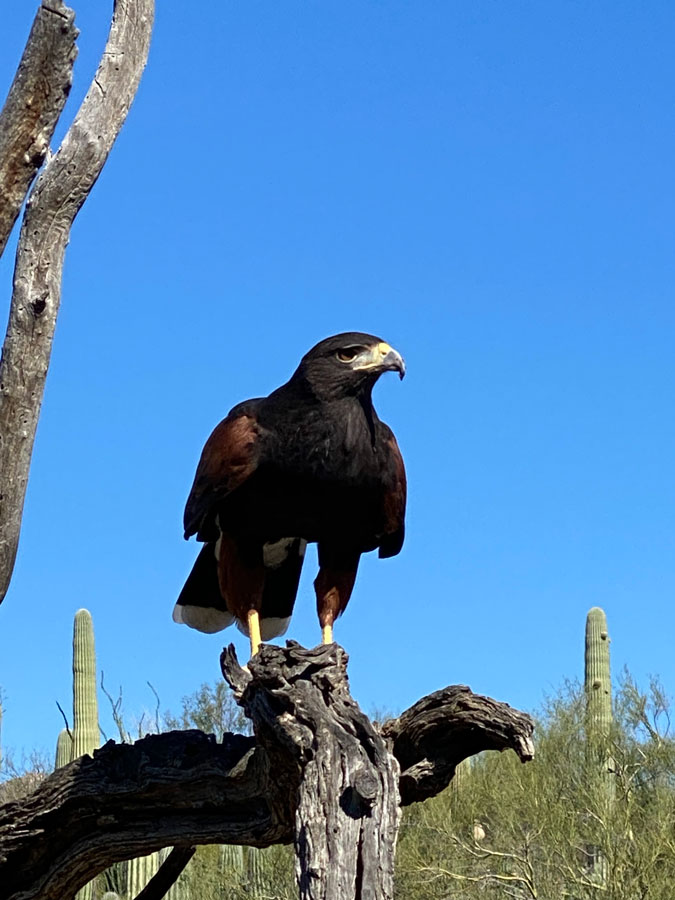They hunt as a pack, led by the dominant female. Working together, they can subdue larger prey than an individual can, providing a feast for the entire family. However, pack isn’t the term used for a group of birds. But the flock doesn’t seem strong enough.
All About Harris’s Hawks
These effective hunters are Harris’s hawks (Parabutea unicinctus). They are the only North American raptor species that hunt cooperatively. One member flushes out the prey toward the others or they take turns chasing an animal until it tires. Even though their range extends into South America, it is only in the Sonoran Desert that Harris’s hawks hunt cooperatively in a group of 4-6 members. In Central and South America, they are solitary hunters!
I took a couple of out-of-town friends to the Arizona Sonoran Desert Museum last week. They wanted to see the raptor show, where predatory birds can fly free over the audience. Twice, the hawks zoomed past my head, brushing my ear with their wings. The last time I was photographing one of the family members, another member flew in to join. It’s a very good thing I was still holding my phone up. It could have been snatched or whacked out of my hand. I did get some great shots.


Many hawks in the desert hunt and eat venomous snakes, such as diamondback rattlesnakes, but not Harris’s hawks. Due to the highly venomous snakes in their southern range, Harris’s hawks avoid all snakes. Better to be safe than sorry.
Harris’s mothers build their nests high off the ground in saguaro cacti, making it difficult for predators to reach them. Once again, raising young is a family affair, with family members participating in the rearing of chicks. It is very unusual for raptors. In fact, it may be unique among the American species.

Along with communal hunting, Harris’s hawks have another exciting behavior, “back-standing.” Harris’s hawks will stand on top of each other! This might give the family a better view of the surrounding territory or help them shade each other. I’d hate to be the one at the top.
I often see Harris’s hawks flying about, but my most memorable encounter was just after I knew that Button, the Missouri Foxtrotter, would become my trail horse. We were practicing riding by ourselves through the neighborhood near the training stables. As we headed down the road, six Harris’s hawks landed and encircled us. Button and I stopped and examined the birds. What was their intent? Did they really think they could subdue us as prey? Were the parents merely showing their chicks to the neighbors? As we edged forward, the hawks adjusted their positions, encircling us. They stared. We stared. Although I knew they couldn’t hurt us, I didn’t want Button to be startled. Button and I kept our cool, but I decided I was not too fond of the situation, so we turned around. I’ve often wondered just what it was the Hawks were doing.
It’s always a pleasure to see these adaptive predators. Living in the Sonoran Desert does take cooperation and flexibility from all its inhabitants.
Are you interested to learn more about plants and animals of the Sonoran Desert? My downloadable workbooks on Lyric Power Publishing are just the thing. Find out about rattlesnakes, roadrunners, and more!
j. Raptor Res. 27(3):143-148 ¸ 1993 The Raptor Research Foundation, Inc. OBSERVATIONS ON THE COMPARATIVE BEHAVIORAL ECOLOGY OF HARRIS’ HAWK IN CENTRAL CHILE JAIME E. JIMgNEZ et al.
